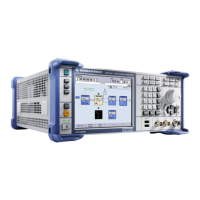Instrument Function
R&S
®
SMBV100A
185Operating Manual 1176.8016.02 ─ 17
Delays of the DUT and transmission over long air paths, where the transmitter and the
receiver are located at separate sites, are therefore not a problem.
5.4.3 CRC Polynomial
In the block error rate measurement, the checksum (CRC) containing the data signal
fed to the DUT is compared with the checksum the block error rate tester calculates
from the feedback data. If the two checksums differ, a block error is counted. The quo-
tient obtained by dividing the number of faulty blocks by the total number of blocks is
the block error rate.
At the beginning of the data, the shift register is initialized with 0. All user data bits are
then shifted through the shift register. The CRC component is then read into a second
register and compared bit by bit with the result of the calculation.
CCITT CRC 16 : G(x) = x
16
+ x
12
+ x
5
+ 1 is the CRC polynomial supported.
The user data is marked by a signal that comes from the DUT and is fed to the "Data
Enable" input, see Figure 5-1.
5.4.4 Clock Signal
Usually the DUT provides the clock signal. If not, the bit clock can be extracted from
the CLOCK output connector (only with "Custom Dig Mod" signals in real time). If sig-
nals complying with digital standards are generated or if ARB waveforms are used, a
marker signal can be used as a clock. As the DUT causes a delay, the ratio of clock-to-
data transmission times must always be considered and checked with an oscilloscope
if necessary. The R&S SMBV indicates the status of the clock and data lines and of the
synchronization in the menus.
5.4.5 Ending the Measurement
The measurement results usually are in the range of 10
-2
to 10
-9
for the bit error rate,
and in the range of 10
-2
to 10
-4
for the block error rate. Hence, a large number of bits or
blocks must be tested before a faulty bit or block occurs. Because of the large number
of bits/blocks, the measurement takes long time. Since 32-bit-wide counters are used
for the total number of bits/blocks and the number of error bits, the maximum measure-
ment time is 4.29 x 10
9
bits.
To keep the measurement times short for both small and large bit/block error rates, the
R&S SMBV provides a number of ways to end the measurement.
In addition to manually interrupting the count, two termination criteria can be selected:
●
Reaching a user-defined number of checked data bits/blocks.
●
A maximum number of detected errors.
The measurement stops as soon as one of the two criteria has been met. The display
shows which of the two criteria caused the measurement to stop.
Bit and Block Error Rate Measurements

